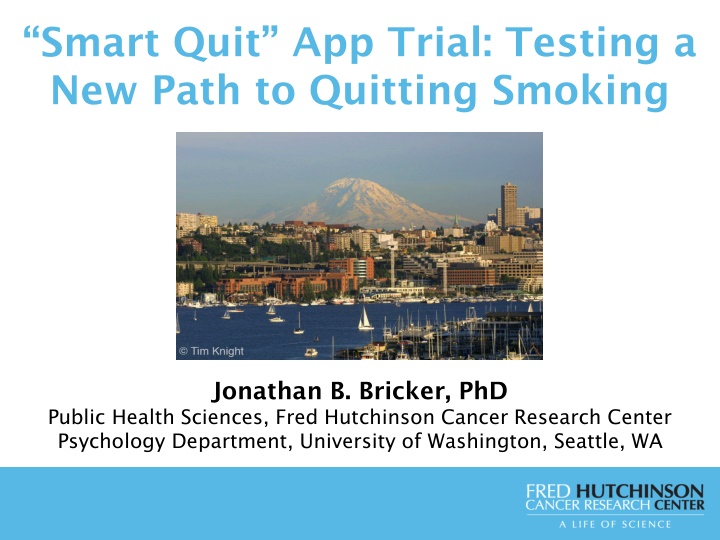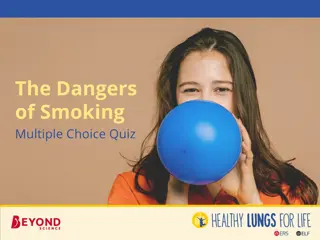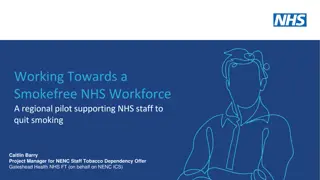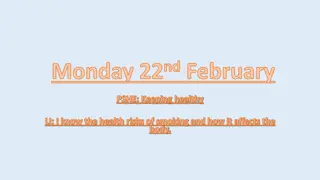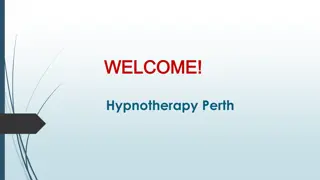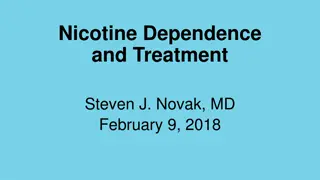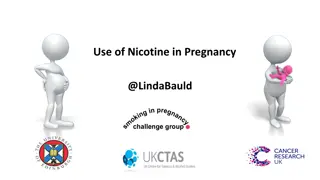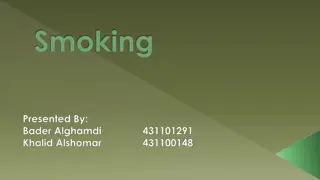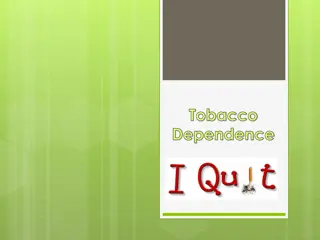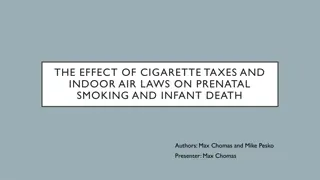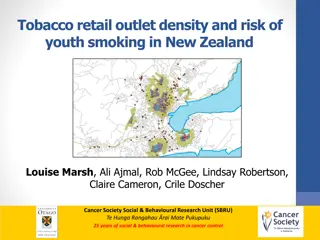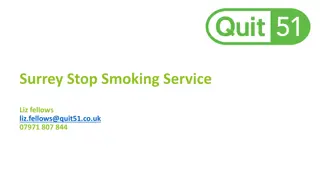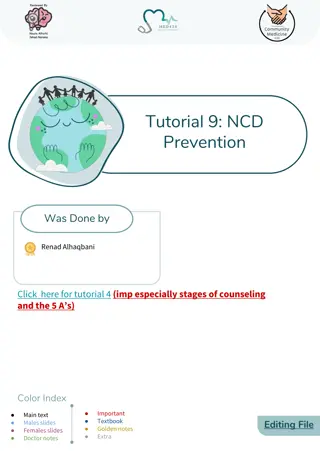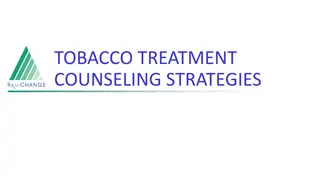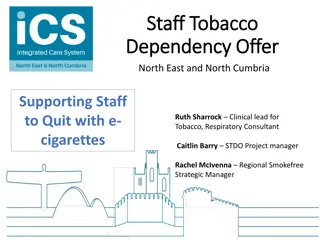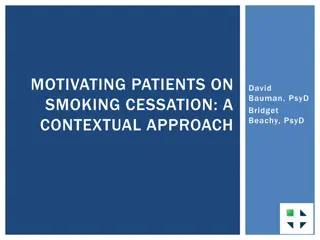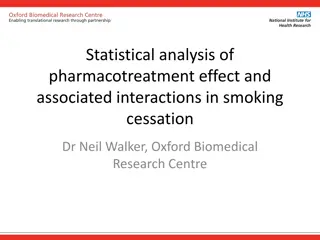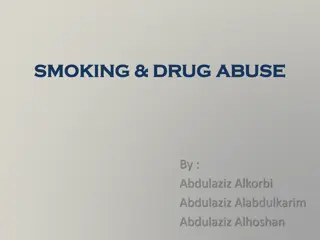Smart Quit App Trial: Testing a New Path to Quitting Smoking
This trial by Jonathan B. Bricker, PhD, explores the efficacy of a smartphone app intervention to help individuals quit smoking. The app aims to address the low quit rates associated with tobacco use by providing a novel approach combining intervention and technology.
Download Presentation

Please find below an Image/Link to download the presentation.
The content on the website is provided AS IS for your information and personal use only. It may not be sold, licensed, or shared on other websites without obtaining consent from the author.If you encounter any issues during the download, it is possible that the publisher has removed the file from their server.
You are allowed to download the files provided on this website for personal or commercial use, subject to the condition that they are used lawfully. All files are the property of their respective owners.
The content on the website is provided AS IS for your information and personal use only. It may not be sold, licensed, or shared on other websites without obtaining consent from the author.
E N D
Presentation Transcript
Smart Quit App Trial: Testing a New Path to Quitting Smoking Jonathan B. Bricker, PhD Public Health Sciences, Fred Hutchinson Cancer Research Center Psychology Department, University of Washington, Seattle, WA
Acknowledgments Katrina Akioka, BS, Project Manager, FHCRC Jessica Harris, MA, Research Therapist, FHCRC Jaimee Heffner, PhD, Psychologist, FHCRC Julie Kientz, PhD, Computer Scientist, UW Brandon Masterson, CEO, 2 Morrow Inc. Jo Masterson, COO, 2 Morrow Inc. Laina Mercer, MS, Statistician, FHCRC Roger Villardaga, PhD, Psychologist, UW Nutrition Assessment Shared Resource, FHCRC Hartwell Innovation Fund, FHCRC
The Journey Ahead The problems of tobacco use & intervention ACT by Smartphone: Addresses the low quit rate problem with novel intervention and technology Overview of our ACT Smart Quit intervention Live demonstration of Smart Quit Design and Baseline Data on Randomized Trial
Todays Tobacco Consequences The leading cause of preventable death, killing 440K US (CDC, 2008) & 5 million worldwide (Hatsumaki et al., 2008). Adult smoking: 19% in US (CDC, 2013). Causes hypertension, CHD, stroke, and multiple cancers (USDHHS, 2004). $193 Billion in US medical and lost productivity costs (CDC, 2008).
US Cessation Treatment: Reach & Efficacy 30% Individual Group Efficacy (% Quit at 12 months) 20% Telephone Web 10% 1m 2m 3m 4m US Reach (# of million using modality annually)
mHealth Smartphone Apps 44 million downloads in 2012 and 142 million expected in 2016 (Juniper Research, 2012) Low cost, real time ways to assess and change behavior Need to evaluate these new technologies for their efficacy (Francis Collins, NIH Director, 2012)
Quit Smoking Smartphone Apps High Growth: Since 2007, growth from a few to over a thousand apps available Unknown Efficacy: Never been tested before!
Smart Quit App User Design Begin: An evidence-based quit plan Ongoing: Push and pull ACT tips for quitting Review: Tracking & Progress Sharing: Inner Circle, Facebook, Twitter
Splash Intro and How to Use App Set up of My Quit Plan Intro and How to Use App Set up of My Quit Plan Splash Main Menu Once My Quit Plan is set up, app will always open to Main Menu Overview of App Structure Main Menu My Quit Plan Main Tracking My Quit Plan Progress Sharing Reports Staying Motivated Staying Motivated Reports Locations Having an Urge Having an Urge Locations Badges Badges I Slipped
Usability Testing Revisions Six Rounds of Testing: 4 internal/2 external Identified 150 Total Revisions Primary Revisions: Logic/Flow Errors (e.g., buttons lead to wrong screen) Content Changes (e.g., text too wordy) Aesthetics (e.g., fonts too small/bad colors)
Smart Quit Referral Sources Overall (n=196) 39% 13% 10% 8% 7% 7% 5% 4% 4% 3% How did you find our website? Our Facebook Ad Television Radio Website Our Google Ad Newspaper smartquit.org in search results Fhcrc.org Doesn t know source Other
Screened: 738 Eligible: 400 Smart Quit Enrollment Diagram Consented: 340 Confirmed by phone: 205 Randomized: 196 Smart Quit: 98 Quit Guide: 98 Two-month Follow-up Survey Two-month Follow-up Survey
Smart Quit Demographics Baseline Characteristic Smart Quit (n=98) Quit Guide (n=98) Overall (n=196) Female 53% 51% 52% Caucasian/Non-Hispanic 81% 88% 84% Married 37% 46% 41% Working 71% 73% 72% Completed at least some college 86% 88% 87% Smokes within 5 min of waking 30% 28% 29% Smokes more than one pack per day 28% 21% 24% Consumes > 5 alcoholic beverages on typical day 25% 22% 23% Living with partner who smokes 24% 21% 23% Any 5 close friends who smoke 74% 73% 74%
Smart Quit Outcomes Engaged?: (a) # times app opened, (b) # times specific pages viewed, (c) length of page views Does engagement predict quit rates? Is SmartQuit better than Quit Guide?: Compare satisfaction, quit attempts, & quit rates
Conclusions Quit smoking apps have high reach & consumer demand Apps are untested Smart Quit is now being tested to address consumer need for quality app
Many Thanks! Contact: Dr. Jonathan Bricker Email: jbricker@uw.edu
